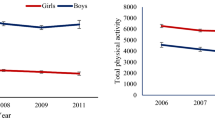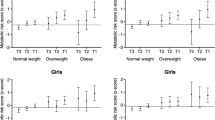Abstract
OBJECTIVE: To evaluate the 6-month impact of a physical activity (PA) multilevel intervention on activity patterns and psychological predictors of PA among adolescents. The intervention was directed at changing knowledge and attitudes and at providing social support and environmental conditions that encourage PA of adolescents inside and outside school.
SUBJECTS AND DESIGN: Randomised, controlled ongoing field trial (ICAPS) in middle-school's first-level adolescents from eight schools selected in the department of the Bas-Rhin (Eastern France) with a cohort of 954 adolescents (92% of the eligible students) initially aged 11.7±0.6 y. The 6-month changes in participation in leisure organised PA (LOPA), high sedentary (SED) behaviour (>3h/day), self-efficacy (SELF) and intention (INTENT) towards PA were analysed after controlling for baseline measures and different covariables (age, overweight, socioprofessional occupation), taking into account the cluster randomisation design.
RESULTS: The proportion of intervention adolescents not engaged in organised PA was reduced by 50% whereas it was unchanged among control students. After adjustment for baseline covariables, LOPA participation significantly increased among the intervention adolescents (odds ratio (95% confidence interval) (OR)=3.38 (1.42–8.05) in girls; 1.73 (1.12–2.66) in boys), while high SED was reduced (OR=0.54 (0.38–0.77) in girls; 0.52 (0.35–0.76) in boys). The intervention improved SELF in girls, whatever their baseline LOPA (P<10−4) and INTENT in girls with no baseline LOPA (P=0.04). SELF tended to improve in boys with no baseline LOPA, without reaching statistical significance. When included in the regression, follow-up LOPA was associated with improvement of SELF in girls (P=0.02) and of INTENT in girls with no baseline PA (P<0.02). The intervention effect was then attenuated.
CONCLUSION: After 6 months of intervention, ICAPS was associated with a significant improvement of activity patterns and psychological predictors, indicating a promising approach for modifying the long-term PA level of adolescents.
This is a preview of subscription content, access via your institution
Access options
Subscribe to this journal
Receive 12 print issues and online access
$259.00 per year
only $21.58 per issue
Buy this article
- Purchase on Springer Link
- Instant access to full article PDF
Prices may be subject to local taxes which are calculated during checkout

Similar content being viewed by others
References
World Health Organization. Obesity: preventing and managing the global epidemic. Publication WHO/NUT/NCD/98.1. WHO: Geneva; 1998.
Livingstone B . Epidemiology of childhood obesity in Europe. Eur J Pediatr 2000; 159: S14–S34.
Klein-Platat C, Wagner A, Haan MC, Arveiler D, Schlienger JL, Simon C . Prevalence and sociodemographic determinants of overweight in young French adolescents. Diabetes Metab Res Rev 2003; 19: 153–158.
Andersen RE, Crespo CJ, Bartlett SJ, Cheskin LJ, Pratt M . Relationship of physical activity and television watching with body weight and level of fatness among children: results from the Third National Health and Nutrition Examination Survey. JAMA 1998; 279: 938–942.
Goran MI, Reynolds KD, Lindquist CH . Role of physical activity in the prevention of obesity in children. Int J Obes Relat Metab Disord 1999; 23: S18–S33.
Molnar D, Livingstone B . Physical activity in relation to overweight and obesity in children and adolescents. Eur J Pediatr 2000; 159: S45–S55.
Armstrong N, Van Mechelen W . Are young people fit and active?. In: Biddle S, Sallis J, Cavill N (eds). Young and active?. Health Education Authority: London; 1998. 69–97.
Campbell K, Waters E, O'Meara S, Kelly S, Summerbell C . Interventions for preventing obesity in children. Cochrane Database System Rev 2002; 4: CD001871.
Kahn EB, Ramsey LT, Brownson RC, Heath GW, Howze EH, Powell KE, Stone EJ, Rajab MW, Corso P, the Task Force on Community Preventive Services. The effectiveness of interventions to increase physical activity. A review. Am J Prev Med 2002; 22: 73–107.
Davison KK, Birch LL . Childhood overweight: a contextual model and recommendations for future research. Obes Rev 2001; 2: 159–171.
Booth SL, Sallis JF, Ritenbaugh C, Hill JO, Birch LL, Frank LD, Glanz K, Himmelgreen DA, Mudd M, Popkin BM, Rickard KA, St Jeor S, Hays NP . Environmental and societal factors affect food choice and physical activity: rationale, influences, and leverage points. Nutr Rev 2001; 59: S21–S39.
Cole TJ, Bellizzi MC, Flegal KM, Dietz VH . Establishing a standard definition for child overweight and obesity worldwide: international survey. BMJ 2000; 320: 1240–1243.
Pereira MA, Fitzgerald SJ, Gregg EW, Joswiak ML, Ryan WJ, Suminski RR, Utter AC, Zmuda JM . A collection of physical activity questionnaires for health-related research: The Modifiable Activity Questionnaire for Adolescents. Med Sci Sports Exerc 1997; 29: S79–S82.
Aaron DJ, Kriska AM, Dearwater SR, Cauley JA, Metz KF, Laporte RE . Reproducibility and validity of an epidemiologic questionnaire to assess past year physical activity in adolescents. Am J Epidemiol 1995; 142: 191–201.
Reynolds KD, Killen JD, Bryson SW, Maron DJ, Taylor CB, Maccoby N, Farquhar JW . Psychosocial predictors of physical activity in adolescents. Prev Med 1990; 19: 541–551.
Story M . School-based approaches for preventing and treating obesity. Int J Obes Relat Metab Disord 1999; 23: S43–S51.
Sherwood NE, Jeffery RW . The behavioral determinants of exercise: implications for physical activity interventions. Annu Rev Nutr 2000; 20: 21–44.
Robinson TN . Television viewing and childhood obesity. Pediatr Clin N Am 2001; 48: 1017–1025.
Sallis JF, Prochaska JJ, Taylor WC . A review of correlates of physical activity of children and adolescents. Med Sci Sports Exer 2000; 32: 963–975.
Department of Health and Human Services. Physical activity and health: a report of the Surgeon General, Centers for Disease Control and Prevention: Atlanta, National Center for Chronic Disease Prevention and Health Promotion GA 1996.
Gortmaker SL, Peterson K, Wiecha J, Sobol AM, Dixit S, Fox MK, Laird N . Reducing obesity via a school-based interdisciplinary intervention among youth: Planet Health. Arch Pediatr Adolesc Med 1999; 153: 409–418.
Acknowledgements
This study was supported by grants from the Caisse Régionale d'Assurance Maladie d'Alsace Moselle (CRAMAM), French National Plan for Nutrition and Health (PNNS), INSERM, Conseil General of the Bas-Rhin, Communes of Drusenheim, Illkirch-Graffenstaden, Obernai and Schiltigheim and Masterfoods. We thank the school boards, teachers and medical staffs for their active participation and F Ghazlane for her technical assistance.
Author information
Authors and Affiliations
Corresponding author
Rights and permissions
About this article
Cite this article
Simon, C., Wagner, A., DiVita, C. et al. Intervention centred on adolescents' physical activity and sedentary behaviour (ICAPS): concept and 6-month results. Int J Obes 28 (Suppl 3), S96–S103 (2004). https://doi.org/10.1038/sj.ijo.0802812
Published:
Issue Date:
DOI: https://doi.org/10.1038/sj.ijo.0802812
Keywords
This article is cited by
-
Using the R = MC2 heuristic to understand barriers to and facilitators of implementing school-based physical activity opportunities: a qualitative study
BMC Public Health (2024)
-
Psychological symptoms are associated with screen and exercise time: a cross-sectional study of Chinese adolescents
BMC Public Health (2020)
-
Screen Time and Health Indicators Among Children and Youth: Current Evidence, Limitations and Future Directions
Applied Health Economics and Health Policy (2017)
-
“Whole-of-Community” Obesity Prevention: A Review of Challenges and Opportunities in Multilevel, Multicomponent Interventions
Current Obesity Reports (2016)
-
A socio-ecological approach promoting physical activity and limiting sedentary behavior in adolescence showed weight benefits maintained 2.5 years after intervention cessation
International Journal of Obesity (2014)



